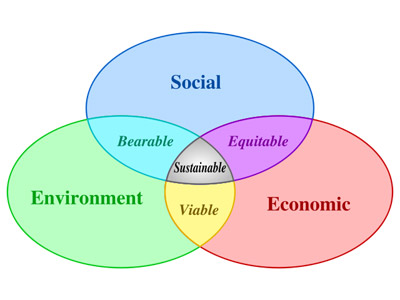by Karen Wrightwheel
(Alabama, USA)

Sustainability
Sustainability – The breadth and depth of environmental initiatives from some of the world’s biggest companies continues to impress us. In recent years, we’ve seen General Electric, BP, Dupont, and other behemoths embark on journeys to create new business value from products and services that reduce their, and their customers’, environmental impacts.
Over the past year, two more giants have stepped up to the plate. Wal-Mart unleashed a dizzying array of initiatives, beginning the year with a companywide sustainability plan dubbed Sustainability 360, aimed at making environmental concerns central to its business decisions. As part of that initiative, Wal-Mart said it would challenge its employees and suppliers to start thinking about how to eliminate non-renewable energy used to manufacture products the company sells. The company held a sustainability summit of major suppliers, exceeded its goal of selling 100 million compact fluorescent lightbulbs during 2007, and eventually announced it would launch its own brand of compact fluorescent light bulbs.
And it worked with major manufacturers of laundry detergent to orchestrate an industry wide shift toward concentrated versions in smaller packaging, reducing both packaging and shipping emissions.
The retailer also announced plans to measure the energy use and emissions of its entire supply chain for seven product categories to find ways to increase their energy efficiency; and to begin scoring its electronics suppliers’ sustainability practices in order to offer its customers products that are more resource efficient and less polluting.
Wal-Mart promoted green thinking to its 1.3 million U.S. employees, too, by encouraging them to develop “Personal Sustainability Projects,” employee driven efforts through which Wal-Mart and Sam’s Club employees set individual goals to improve their health and the health of the environment. And it began installing solar panels on some of its stores.
Meanwhile, another big dog, Google, launched its own parade of sustainability initiatives. The company has embraced a wide range of environmentally friendly practices. Some of them, like the company’s fleet of 32 Wi-Fi-enabled, biodiesel powered employee shuttle buses, are aimed at attracting and retaining talent as much as at reducing its footprint. But its efforts are far from symbolic.
Google accelerated its actions last year to create green innovations that reduce the environmental impacts of its data centers.Google also invested in new technologies that could benefit all companies. For example, as the search-engine company completed a massive solar installation at its headquarters, it announced plans to invest hundreds of millions of dollars in developing renewable energy technologies that cost less than conventional coal-fired electricity. It also made a foray into the world of electric cars, launching an initiative to invest $10 million in companies that help speed up the widespread use of plug-in hybrid vehicles, electric vehicles, and vehicle-to-grid technologies.
All that was left was for the company to declare its intention of going carbon neutral, which it did, announcing a goal of doing so by the end of 2007.
The report makes for an interesting read, but guess one wonders if many of these businesses are really sustainable.
This was extracted from: State of GREEN BUSINESS 2008 – http://www.stateofgreenbusiness.com/
